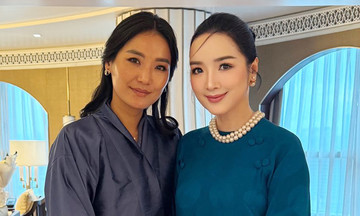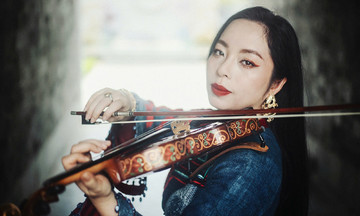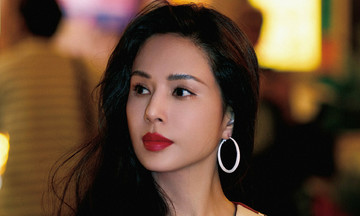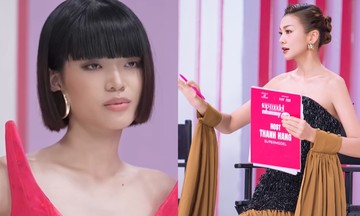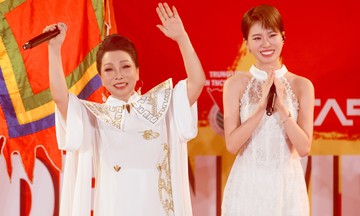At a seminar on 9/8 commemorating the 100th anniversary of the birth of People's Teacher and musician Hoang Kieu (1925-2025), many artists recalled his significant contributions, including his groundbreaking work in cheo music through the opera Suy Van.
Written by Han The Du, based on the classic Kim Nham tale, and directed by People's Artist Tran Bang, the revised version centers on Suy Van. Unhappy with Kim Nham's decision to take a concubine, Suy Van is seduced by Tran Phuong, feigns madness, abandons her husband, and follows him. Ultimately, she is abandoned by Tran Phuong and tragically takes her own life. Suy Van embodies a modern female figure who yearns for love and dares to challenge the polygamous traditions of the old society.
The music in Suy Van is innovative while preserving the essence of cheo. Le Tuan Cuong, acting director of the Vietnam Cheo Theater, considers the music a phenomenon of 20th-century cheo. He notes how in the first scene, where Suy Van weaves and sings the To Vo melody, Hoang Kieu composed in polyphony, building upon and developing traditional forms. He orchestrated the music, dividing the breaths, ranges, and pitches of the voices. This division of parts allows the melody to convey the anxieties of a woman longing for the return of her husband, who is away studying for the imperial examinations.
People's Artist Thanh Ngoan highlights the use of choral arrangements as Hoang Kieu's creative hallmark. Traditional cheo singing typically features male "voi" and female "luon" vocals, a monophonic, single-line style. In Suy Van, Hoang Kieu actively incorporates choral arrangements from the main vocal parts, pioneering a polyphonic, multi-layered approach to modern cheo music.
The choral parts are not simply divided into two layers—one following Suy Van's main melody and the other highlighting the climax—but are arranged to create an effect like undercurrents. "The female voices, when blended with Suy Van's solo, embellish it like echoing inner thoughts, deepening the character's internal struggle," Thanh Ngoan writes. Even within the To Vo melody, Hoang Kieu's treatment allows the audience to feel the shared longing of women in feudal society, patiently waiting for their husbands.
Thanh Ngoan recalls the initial confusion she and other actors felt when a chorus was introduced to support the main melody. Only through learning and practice did she understand the value of the arrangement. She believes this doesn't detract from the traditional cheo essence but enhances emotional depth and symbolism. The seamless blend of music with the script, lyrics, character traits, and expressive language often made her feel as if she were performing a classic cheo piece, not a newly composed work.
In traditional cheo, the music usually consists of drums, clappers, or existing folk melodies. In Suy Van, Hoang Kieu introduced background music, blending modern musical structure with a national spirit. Musician Khac Hien, former director of the Ha Nam Cheo Theater, calls the music "an immortal symphony of the Vietnamese soul." He describes the "feigned madness" scene as "a masterpiece of expression and sound design, revealing the character's psychological depth through every nuance, inflection, and subtle dialogue between the vocals and traditional instruments."
The character of Suy Van is associated with generations of artists, including People's Artist Thuy Ngan. After more than 40 years dedicated to cheo, she still gets "goosebumps" when the opera's music plays. In her commentary, she writes: "The music of Suy Van is so perfect that it's almost flawless. The first and second parts express the character's endless, boundless sorrow." She mentions the passage where Hoang Kieu uses music to depict the character's dilemma: "To go is to face the mountain, to return is to face the river," illustrating the helplessness of women in feudal times. Many generations of actors at the Vietnam Cheo Theater are impressed by how Hoang Kieu revolutionized cheo music, ensuring Suy Van's enduring appeal.
Hoang Kieu, whose real name was Ta Khac Ke, was born in Kim Dong, Hung Yen. He studied in Wuhan, China, from 1950 to 1953 and later worked at the Central People's Art Troupe. In 1956, he headed the Music and Dance Research Department of the Ministry of Culture and Information. He held various other positions, including Director of the Vietnam Cheo Theater, Principal of the Intermediate School of Theater Arts under the Ministry of Culture and Information, Vice-Principal of the University of Theater and Cinema, and Head of the Department of Traditional Theater. He retired in 1989 and passed away in 2017 from age-related illness.
Hoang Kieu was a pioneer in experimenting with, adapting, and writing multi-part harmonies for cheo singing. He also composed for traditional theater, with many works on revolutionary themes such as Our Blood Has Flowed (1963), Father and Son, the Lighthouse Keepers (1969), The Girls on the Street (1969), and The Vegetable Vendor (1980). He also composed instrumental pieces like Red River (1963) and dance music like Joy of Production (1954) and Five Thunder Drums (1950).
He wrote scripts for numerous cheo and cai luong operas, including A Thousand Gold Coins of Love and Hate, The Female Scholar, and Wild Ambition. His research, theory, and criticism on theater include Using Cheo Melodies (1974), Vietnamese Tones and Traditional Music (2001), Exploring Ancient Cheo Melodies (2001), and The History and Development of Cheo Theater (2009).
 |
Portrait of musician Hoang Kieu. Photo: *Courtesy of the family* |
Phuong Linh





